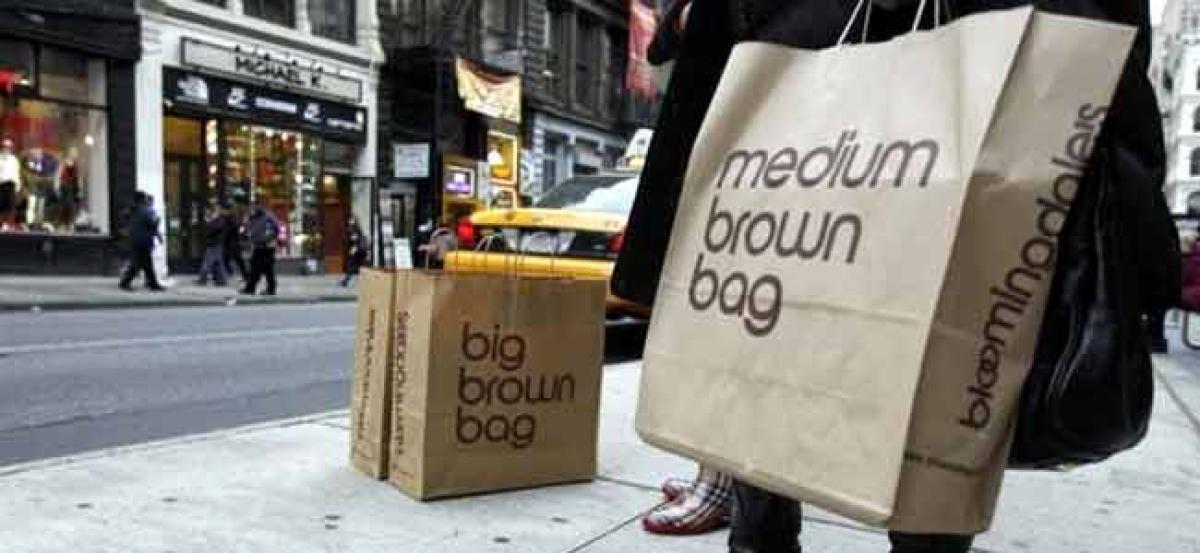Live
- Air India Express row: 'Company leadership available for discussions', CEO says in letter to employees
- 'When will Shiv Sena-UBT merge with Congress', asks BJP & Shinde camp
- RBI lifts ban on Bank of Baroda's BoB World
- Youth should come forward for blood donation: District Medical Officer Dr. Sudhakar Lal
- Grand Farewell Day Celebrations in Government Degree College
- PM Modi holds roadshow in Vijayawada with Chandrababu Naidu, Pawan Kalyan
- Farmers should be alerted: District Collector Uday Kumar
- 95 more Myanmar refugees enter Mizoram to avoid 'forceful' induction in militant outfit
- Punish Congress for Pitroda's 'racial' comments: PM Modi
- RML Hospital bribery case: CBI books over 15 including 2 doctors
Just In

The U.S. economy accelerated in the second quarter as consumers ramped up spending and businesses invested more on equipment, but persistent sluggish wage gains cast a dark shadow over the growth outlook.
WASHINGTON: The U.S. economy accelerated in the second quarter as consumers ramped up spending and businesses invested more on equipment, but persistent sluggish wage gains cast a dark shadow over the growth outlook.
Gross domestic product increased at a 2.6 percent annual rate in the April-June period, which included a boost from trade, the Commerce Department said in its advance estimate on Friday. That was more than double the first quarter's downwardly revised 1.2 percent growth pace.
Wage growth, however, decelerated despite an unemployment rate that averaged 4.4 percent in the second quarter. Inflation also retreated, appearing to weaken the case for the Federal Reserve to raise interest rates again this year.
"Although growth is solid, the lack of wage pressure buys the Fed plenty of time, and works with a very 'gradual' tightening cycle," said Alan Ruskin, global head of G10 FX strategy at Deutsche Bank in New York. "There is more here for the Fed doves than the hawks."
Prices of U.S. Treasuries rose after the data but pared gains as oil prices hit two-month highs. The dollar .DXY fell against a basket of currencies and stocks on Wall Street were trading mostly lower following recent hefty gains.
Economists expect the Fed to announce a plan to start reducing its $4.2 trillion portfolio of Treasury bonds and mortgage-backed securities in September.
The U.S. central bank left rates unchanged on Wednesday and said it expected to start winding down its portfolio "relatively soon." The Fed has raised rates twice this year.
The rise in second-quarter GDP was in line with economists' expectations. Output was previously reported to have increased at a 1.4 percent pace in the first quarter.
The economy grew 1.9 percent in the first half of 2017, making it unlikely that GDP would top 2.5 percent for the full year. President Donald Trump has set an ambitious 3.0 percent growth target for 2017.
Speaking to law enforcement officers in Brentwood, New York, Trump applauded the GDP data and said it was the result of his administration's rollback of some business and environmenal regulations.
"We're doing well, we're doing really well and we took off all those restrictions," Trump said. "Some we're statutorily stuck with for a little while, but eventually that statute comes up and we're going to be able to cut a lot more."
But analysts are skeptical of the Republican president's vow to push through major tax cuts in the wake of his party's failure early on Friday in the Senate to pass a bill that would have repealed parts of former President Barack Obama's 2010 healthcare law.
So far, the political gridlock in Washington has not hurt either business and consumer confidence.
Consumers Boost Growth
A resurgence in consumer spending accounted for the bulk of the pickup in economic growth in the second quarter. Consumer spending, which makes up more than two-thirds of the U.S. economy, grew at a 2.8 percent rate. That was an acceleration from the 1.9 percent pace logged in the first quarter.
But with wage growth remaining sluggish despite the labor market being near full employment, there are concerns that consumer spending could slow in the third quarter.
In a separate report on Friday, the Labor Department said wages and salaries increased 0.5. percent in the April-June period after accelerating 0.8 percent in the first quarter.
They rose 2.3 percent on a year-on-year basis. There were, however, strong wage gains in the information, finance and natural resources sectors.

© 2024 Hyderabad Media House Limited/The Hans India. All rights reserved. Powered by hocalwire.com







